Last push before the snow
- By Julia Pankratova
- 2013, 15 November
- No Comments
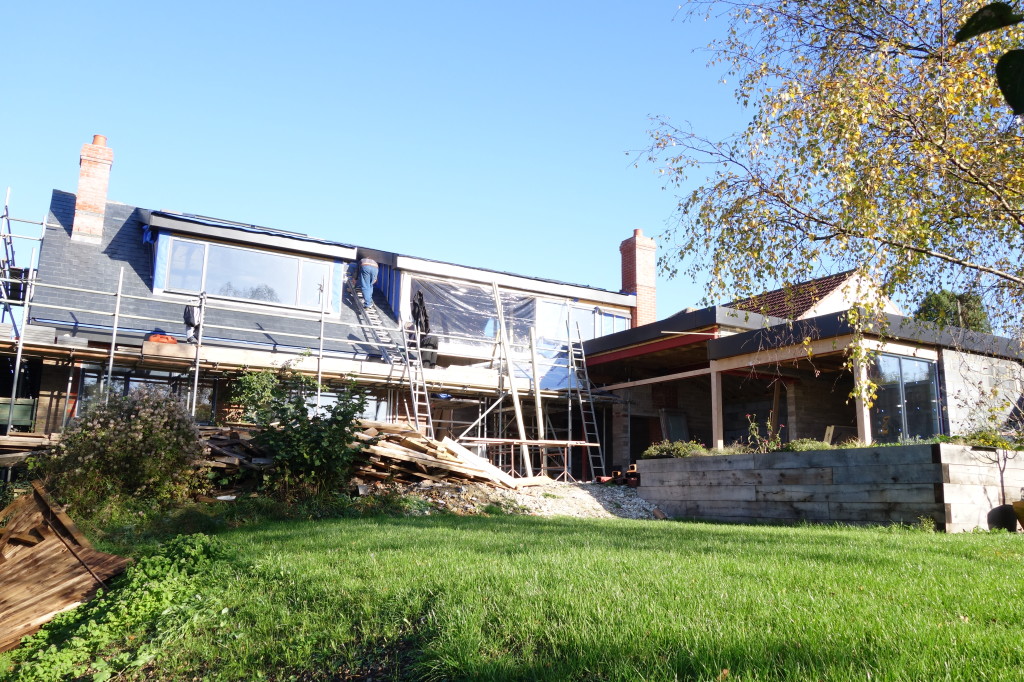 It’s been a whole month since our last post and lots happened: small wins, big wins, progress on some fronts, hold-ups and delays on others, good stuff, not so good stuff, ups, downs… and that’s just in one “regular” day! And with numerous media sources forecasting the winter’s start next week – we are under even more stress and in even bigger a rush to get as much done as possible! It can be very tense at times. Yet, had it been all hunky-dory – I am sure I would have probably got bored by now and left the site in search of a better challenge! 😀
It’s been a whole month since our last post and lots happened: small wins, big wins, progress on some fronts, hold-ups and delays on others, good stuff, not so good stuff, ups, downs… and that’s just in one “regular” day! And with numerous media sources forecasting the winter’s start next week – we are under even more stress and in even bigger a rush to get as much done as possible! It can be very tense at times. Yet, had it been all hunky-dory – I am sure I would have probably got bored by now and left the site in search of a better challenge! 😀
News flash : We HAVE hot water! Millions take it for granted, turning the hot water tap numerous times a day for numerous reasons without a single thought. That little thought was ingrained in our minds from the first day we cut the pipe in August to the day we reconnected it last Sunday. The thought is gone. The thought’s mammoth imprint is there to stay 🙂 The dropping temperatures, northerly winds and lack of central heating, doors and windows, made each shower trip over the past few months more and more torturous. Last Sunday’s hot shower was my life’s most memorable experience – it was heaven! At this stage it is only overshadowed by the auspicious experience we had watching the auroras in the very north of Norway two years ago 🙂 The plumbing arrangement may only be temporary at the moment but will keep us sane, warm and clean through the snow storms 🙂
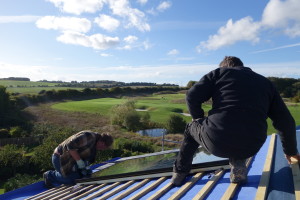
Other things plumbing: our solar thermal panels are in, though not yet connected. As nice as they looked in their packaging, and as nice as they are looking now on the roof – they were a true pain to install! The roofer spent two full days messing around with the flashing kits, using Fairy liquid and Windolene (on manufacturer’s advice!) to no avail!
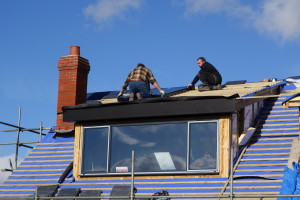
It took in the end two men, Richard the roofer and Malc, to get all the kits into place! Something that was meant to be as easy to install as a Velux window was far from it! Another big minus was the lack of any kind of specialist piping to connect the panels with the pump station in the plant room – kind of an essential ingredient in getting the system working and tested!!! Turns out it is to be sourced separately at a lofty £450, making the total cost of the solution not all that attractive any longer. So far, that’s two minuses to the manufacturer. An email with design alteration suggestions as well as a complaint for misselling
and misquoting will be going out next week.
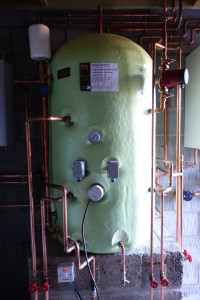 The thermal heat store is now in too, looking very alien with all the copper sticking out in all directions. Andy the plumber did a great job getting it all prepped up for the D-Day when we get our Morso wood burning stove in, which incidentally still has not turned up! Out of the two ordered stoves the Stovax double-sided stove which we needed least turned up first ages ago. Yet the one that would keep our current “living quarters” warm and hot water hot is the one that’s letting us down. The good news is that I managed to find HETAS-certified dry and wet (the back boiler bit) appliances plumbers who can make themselves available to install the stove at short notice and tick the relevant boxes.
The thermal heat store is now in too, looking very alien with all the copper sticking out in all directions. Andy the plumber did a great job getting it all prepped up for the D-Day when we get our Morso wood burning stove in, which incidentally still has not turned up! Out of the two ordered stoves the Stovax double-sided stove which we needed least turned up first ages ago. Yet the one that would keep our current “living quarters” warm and hot water hot is the one that’s letting us down. The good news is that I managed to find HETAS-certified dry and wet (the back boiler bit) appliances plumbers who can make themselves available to install the stove at short notice and tick the relevant boxes.
In short, on the plumbing / heating side we are still due for the solar thermal /wood burner / gas boiler integration into the heat store, all subject to all the bits turning up, wiring being in place and trades being available! Dare I say we may have it all there in the next two weeks 😉 As far as plumbing for the rest of the house is concerned, including underfloor heating, rads and towel rails, thermostats etc – this will have to wait until we are completely weathertight…
Which brings me to the next topic : weather tightness!
Two critical element are still missing to get us to that point: roof completion and windows + external doors installation.
Roof slating started in the first week of October and was meant to take 3-4 weeks weather permitting. It was meant to include felting, battening, slating, lead work and Velux and solar thermal panels installation. Five weeks later we are still at least another week away from completion with slating, lead work and 3 (out of 7) Velux windows outstanding. The roof is thankfully largely leak-free, but it’s just another page that is yarning to be turned! Still, I must admit it is looking great, the slate and the lead work are looking good and neat, and we are also well chaffed with the slate choice. Even the roofer, with 30+ years of roofing experience commented that they (Canadian Glendyne slates) were the best slates he had ever worked with 🙂
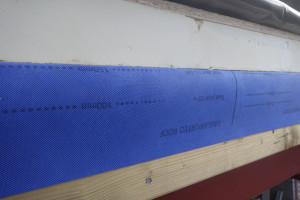 The flat roofs which are eventually destined to be a lush sedum heaven for bees and bugs are now structurally complete and resemble two giant (warm roof) sandwiches of timber and man-made fibres atop of steel frames. Some 65mm EcoTherm insulation went between the roof rafters before getting topped up by 9mm marine ply, a layer of a breathable membrane and an additional 100mm of EcoTherm insulation, all finally topped off with an OSB board. This was the job that saw me putting a nailgun nail through my middle finger as I was hanging upside down nailing battens to the rafters for the insulation. Nothing that a trip to the local GP for a tetanus injection could not have sold :).
The flat roofs which are eventually destined to be a lush sedum heaven for bees and bugs are now structurally complete and resemble two giant (warm roof) sandwiches of timber and man-made fibres atop of steel frames. Some 65mm EcoTherm insulation went between the roof rafters before getting topped up by 9mm marine ply, a layer of a breathable membrane and an additional 100mm of EcoTherm insulation, all finally topped off with an OSB board. This was the job that saw me putting a nailgun nail through my middle finger as I was hanging upside down nailing battens to the rafters for the insulation. Nothing that a trip to the local GP for a tetanus injection could not have sold :).
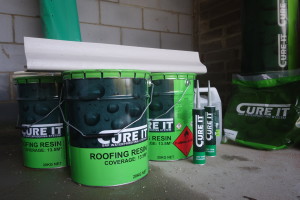 Since then for the last three weeks the flat roofs were sitting under waterproof membranes (still!) getting wet, awaiting for the GRP waterproofing system to go on, comprising of fibreglass matting layers, resin layers, top coat layers and numerous other bits and bobs talking about which sends me off to sleep. We went for the Cure-It manufacturer on the roofing merchant’s advice with our roofer’s approval. A couple of dry days permitting – the roofer may be able to get this job done this weekend, which will bring me onto the next challenge of DIY sedum roofing. The research shall commence this weekend. Can’t wait 🙂
Since then for the last three weeks the flat roofs were sitting under waterproof membranes (still!) getting wet, awaiting for the GRP waterproofing system to go on, comprising of fibreglass matting layers, resin layers, top coat layers and numerous other bits and bobs talking about which sends me off to sleep. We went for the Cure-It manufacturer on the roofing merchant’s advice with our roofer’s approval. A couple of dry days permitting – the roofer may be able to get this job done this weekend, which will bring me onto the next challenge of DIY sedum roofing. The research shall commence this weekend. Can’t wait 🙂
Glass and external doors are the other major ingredient lacking at the moment to get us weather tight. The bi-folds are scheduled to arrive and get installed by Kloeber early next week along with 3 external doors, significantly reducing drafts and making us more secure!
In the meantime a local Southampton glazing company is working on our windows and glass roof structure for the hallway. Something that was initially “sold” as local-short-leadtime-hassle-free two months ago so far induced many heated conversations over the phone and on site. This week the first set of windows arrived… with wrong frame profiles 🙁 Luckily (for the manufacturer), the problem is “easily” solvable, if not cheap on their pocket, and does mean that we will have to wait for another week before the wrong profiles are swapped with the right ones on site. The bigger pain is the glass roof which the glazing company is reluctant to order the triple glass for until the bi-fold doors below are in place next week, to make sure the frames of the bi-folds align exactly with the frames of the roof. This isn’t a problem in itself, but the triple glass is on a 10-day leadtime, meaning we just may be lucky to get all the glass in before December kicks in. Grrrr…. Brrrrr…. :S
Other highlights over the past month:
– Facias and soffits – these are mostly all in place now and looking great, thanks to the great job done by David and Tim the chippies over the past few weekends (who did many other jobs too, including flat roofs construction and steels cladding with marine ply using an insane Hilti gun). The total cost for all the plastic did rise further as the initial quantitative estimate was not quite right, but all the extra money we paid was worth it in the end. The quality and the overall look of these Freefoam’s facias beats the standard white plastic hands down! And I do take my hat off to the manufacturer (Freefoam) and the supplier (Omnico in Eastleigh) who provided great service and support to get the stuff to us on time!
– Cedar cladding – after meticulous research the consensus was to go for cedar for the external wall cladding on the gables and the dormer cheeks.
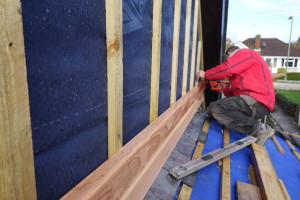
The timber’s properties and qualities such as density, durability and low maintenance, as well as the look and the price were the deciding factors. More expensive than larch or pine softwoods, but cheaper than oak or other (exotic) hardwoods, it’s a decision we have not regretted ever since the 370 linear meters of the ship-lap sawn timber was delivered to us by the Aylesbury-based Artisan Timber. The smell on its own is worth the money! 🙂 Since then Malc and I lined and battened all three gables and all dormer cheeks and so far cladded the Eastern and the Northern gables, completely transforming the front of the house. 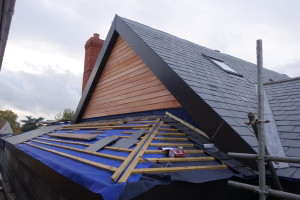 The warm glow of the brown-yellow-orange colour will eventually weather and turn silver unless we treat or stain the wood. We have no intention of doing that however since cedar is the only softwood which does not require any treatment whatsoever to last for many years without rot and decay! The timber looks great and contrasts well against the black facias and the slate roof. I cannot wait for when the render goes on the brick walls, as it will at last look like the house we dreamed up on a piece of paper a year ago! 🙂
The warm glow of the brown-yellow-orange colour will eventually weather and turn silver unless we treat or stain the wood. We have no intention of doing that however since cedar is the only softwood which does not require any treatment whatsoever to last for many years without rot and decay! The timber looks great and contrasts well against the black facias and the slate roof. I cannot wait for when the render goes on the brick walls, as it will at last look like the house we dreamed up on a piece of paper a year ago! 🙂
Next steps, once weathertight, will be insulating floors with more EcoTherm, laying underfloor heating pipes and all plumbing and then pouring in the screed to finish off the floors. Getting both fireplaces installed for warmth and getting the first fix electrics will be another big step. Let there be warmth and light at last! 😀
———————
Last week I came across a website that was offering free solar PV panel installation in return for some sort of a “symbiotic relationship”, which sounded like not a bad deal at the time. Getting in touch via email I discovered that our property had to tick boxes for size, roof orientation, over-shadowing factors etc to qualify for the free installation. A year ago our house represented a small South-facing bungalow with a huge hawthorn tree matching the size of the house in the back garden casting shade on most of the bungalow and the garden. A year on the hawthorn tree is in logs in the woodshed, curing for the next winter’s fire season and no longer causing shadows, the house has nearly doubled in size, and we are still facing south! 🙂 We are a perfect candidate for the installation of the solar PV according to the tick-box list! Alas, we have been turned down.. twice… on the first account based on the supplier’s own Googlemaps research and assumption that the house was too small and in too much shade. On the second account we were turned down since the total south-facing roof space of 65 m sq was not big enough…. If that’s not big than I would like to see what is the scale of the installations they are envisaging and who really is the folk these installations are aimed at… Perhaps these “incentives” aren’t really meant for those of us who are eco-keen but not all that wealthy to be able to easily afford the renewables… Perhaps I should drop a line to Mr Madejski to see if he is interested.
This silly incident brought me across another web application for solar PV panel quotes. Two days later I had three salesmen knocking on my (bi-fold) door. Up until three days ago I struggled to make head or tail out of all that info available online about PV and feed-in tariffs. Now I can confidently say I know more about Solar PV and FIT (Feed-in Tariffs) and Export Tariffs than all three of the salesmen combined :D.
So far all three installers have recommended to install 12 panels based on the dormer roof space available, which would allow for an up to 3-4 kW system depending on the chosen panels. All 12 panels ideally would be fitted with micro inverters to combat the issue of the slight overshadowing from the chimney in the months when the sun travels lower. Turns out that when the PV panels are working on one string with a single inverter, they all are as efficient as the worst performing panel (in our case when one or two are slightly overshadowed by the chimney). The micro inverters enable each panel to work independently as well as being more efficient at energy inversion than a standard inverter. Ignoring the additional £750 cost for the micro-inverters, everyone is a “winner”.
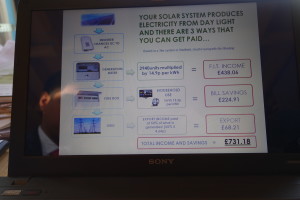 FIT (Feed-In Tariff ) Scheme in a nutshell:
FIT (Feed-In Tariff ) Scheme in a nutshell:
We choose a FIT- participating electricity company we would like to work with and get the installers install the panels (almost all electricity suppliers with the exception of one or two are FIT- participating. This can be the same as our mains electricity supplier, or can be different, depending on personal preference). The FIT (Feed-in Tariff) is fixed for us at the current FIT rate for the next 25 years, but will annually rise with the inflation rate (currently FIT is fixed at 14.9p/kWh with a possible change from January 2014. In general FIT’s prices are falling year-on-year. But then again – the PV technology is getting cheaper too). Once installed, the PV panels generate electricity and feed it back to the grid. A meter registers the total kWh per year generated by the panels. FIT electricity company pays us cash annually for every kWh generated within the year. In addition to that we can use the solar electricity during the day, whilst the panels are generating power, saving on the mains electricity bill by not using the electricity from the grid (during the day only). In addition to that, the FIT electricity company also pays us cash at the Export tariff rate for the 50% of that same total generated electricity, albeit at a lower rate (currently 4.6p /kWh), based on the scheme’s assumption that on average at least 50% of all the generated electricity will go back to the grid. This is not unreasonable, since some of you actually go to work during the day, unlike me 🙂 . In addition to that, we can fit an immersion heater booster to utilise the surplus energy generated to heat the hot water tank, i.e. saving on the heating bill too. This however is available only until the electricity companies decide to fit an export meter in our house, at which point this legal “loophole”, as I see it, will end.
So, as a short summary of total potential benefits, in return for the initial investment in the PV technology, one can get annual FIT and Export Tariff cash payments, as well as save on the mains electricity bill (during the day) & on the water heating bill.
In our case, based on the number of possible panels (12), and the current tariffs, the average calculations showed that we would break even in 8 years before starting to generate pure income, for the following 17 years, taking into account that the actual efficiency of the PV panels is expected to reduce by 20% over that 25 year period… “Then, Rodney, we’ll be millionaires!” 🙂
A few things sprang to mind:
1. To really benefit from free solar electricity during the day, unless one works from home / stays at home / looks after kids etc -would require change of one’s lifestyle and habits, such as sticking everything on charge and on timers to operate in day-light hours, such as washing machines, (slow)cookers, tumble driers, battery and device chargers etc.
2. To benefit from the free water heating energy with the immersion heater booster one must have an immersion heater in the first place as well as have an extra slot in the mains fuse box to wire it in. In our case, the additional cost of £400 for the booster would not add much value as we are hoping that the solar thermal panels will be topping up our thermal store during the day without any additional need from other sources, unless perhaps we each start taking a bath on daily basis 🙂
Having debated over this subject over many months we came to the conclusion that what we would really like is a completely-off-grid solar PV system that can store as much of the generated energy as possible in a battery / energy store, which then can be tapped into whenever electricity is required and the panels are “asleep”. Is it THAT difficult?! Yet, so far none of the suppliers we spoke with have an answers for us… 🙁 Perhaps could be another DIY project at some point 🙂
Would be interesting to hear from you if you have had any good / bad experiences with the renewables / eco technologies or have an integrated system that you may or may not be already ripping the benefits from!

 Copyright © 2024
Copyright © 2024
Leave a Reply